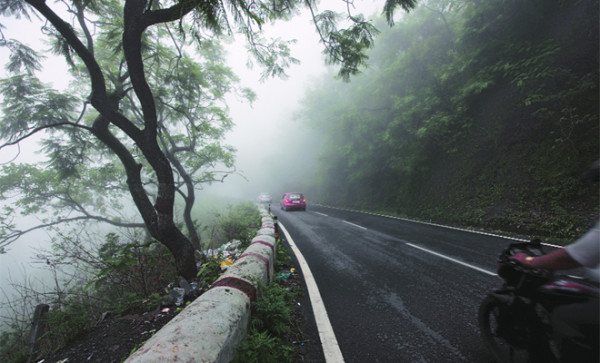June is no month for 370mm rain
04:39AM Wed 26 Jun, 2013

 As authorities try to analyse reasons for the unprecedented death and destruction caused by the rain-induced disaster in Uttarakhand, the unusually high rainfall in Dehradun on June 16 and 17 will have to take part of the blame.
Though the 370 mm of rainfall recorded in Dehradun within a 24-hour period between June 16 and 17 is exceptionally rare, it was not the only of its kind — not even in Uttarakhand. Single-day rainfall in excess of 400 mm has been recorded several times in the state, most recently in 1995 when the Mukhim weather station in Tehri-Garhwal received 450 mm. In 1965, Rajpur weather station in Dehradun recorded 900 mm of rains in 24 hours — comparable to the deluge that Mumbai faced on July 26, 2005, when 944 mm of rainfall drowned and paralysed the city, and claimed nearly 400 lives. There have been other instances of a place receiving more than 500 mm rainfall in a single day.
However, none of these single-day extreme events happened in June. In fact, the 370 mm rainfall in Dehradun happens to be the highest-ever single-day rainfall in June for the state — the previous highest being 350.5 mm in 1970. Instances of such extreme precipitation, of 370 mm or more, have been witnessed not just in the normally wet months of July, August and September but even in January, April and May. But never in June.
The timing becomes crucial in the light of the fact that the state has so far received 401.8 mm of weighted mean rainfall in June, which is about three and a half times more than normal. With more rains being predicted in the coming days, it would not be a surprise if is is the wettest June in Uttarakhand in the last 10 years, overtaking 2008 when it received 593.8 mm rainfall in this month.
The all time record for the wettest June for Uttarakhand happened way back in 1966 with 963.5 mm rainfall.
May and June happen to be the peak pilgrimage time in Uttarakhand, and the number of tourists has witnessed a sharp rise in recent years, as more roads and hotels have come up. Little surprise then, that the worst affected in the disaster have been the pilgrims.
While much of the blame has come on the door of the Met office for not warning Uttarakhand of the impending tragedy sufficiently well in advance, the fact is that IMD was not lacking in doing what it routinely does. It did send a warning to the state, two days before the disaster started unfolding. But the IMD warnings are rarely an indication of the sort of tragedy that was awaiting Uttarakhand.
A typical warning tells a state government that ‘heavy to very heavy rainfall’ was likely to happen in ‘one or two’ or ‘several’ places. Few people know what ‘heavy to very heavy rainfall’ means, or where exactly the rainfall is likely to occur.
In fact, after the Uttarakhand tragedy, the IMD has begun quantifying the amount of rainfall in their ‘heavy to very heavy’ forecasts. On Monday, it warned that ‘heavy to very heavy rainfall (up to 25 cm) would occur at one or two places over Uttarakhand during the next 72 hours’. But the areas falling under ‘one or two places’ still need to be specified, in the absence of which it becomes extremely difficult for any agency to plan for an impending tragedy. In contrast, the warnings about cyclones are extremely precise. The time, strength and path of a cyclone are very well tracked and advance warnings issued, helping in the evacuation of people living in the coastal areas.
“There is a reason for that. Cyclones are very organised weather systems. Advance warning systems for these are very well developed. The wind speed, precipitation, and the path can all be predicted with a fair degree of accuracy. That is not the case with rainfall, especially the phenomena of monsoon,” an independent weather scientist said.
He said the country needed to evolve a three-stage advance warning system for heavy rainfall. A general alert can be followed by a warning with quantified estimate of rainfall expected, which can then be followed up with location specific forecast. “But the state governments also need to be geared up to act promptly on such forecasts,” he said.
Indian Express
As authorities try to analyse reasons for the unprecedented death and destruction caused by the rain-induced disaster in Uttarakhand, the unusually high rainfall in Dehradun on June 16 and 17 will have to take part of the blame.
Though the 370 mm of rainfall recorded in Dehradun within a 24-hour period between June 16 and 17 is exceptionally rare, it was not the only of its kind — not even in Uttarakhand. Single-day rainfall in excess of 400 mm has been recorded several times in the state, most recently in 1995 when the Mukhim weather station in Tehri-Garhwal received 450 mm. In 1965, Rajpur weather station in Dehradun recorded 900 mm of rains in 24 hours — comparable to the deluge that Mumbai faced on July 26, 2005, when 944 mm of rainfall drowned and paralysed the city, and claimed nearly 400 lives. There have been other instances of a place receiving more than 500 mm rainfall in a single day.
However, none of these single-day extreme events happened in June. In fact, the 370 mm rainfall in Dehradun happens to be the highest-ever single-day rainfall in June for the state — the previous highest being 350.5 mm in 1970. Instances of such extreme precipitation, of 370 mm or more, have been witnessed not just in the normally wet months of July, August and September but even in January, April and May. But never in June.
The timing becomes crucial in the light of the fact that the state has so far received 401.8 mm of weighted mean rainfall in June, which is about three and a half times more than normal. With more rains being predicted in the coming days, it would not be a surprise if is is the wettest June in Uttarakhand in the last 10 years, overtaking 2008 when it received 593.8 mm rainfall in this month.
The all time record for the wettest June for Uttarakhand happened way back in 1966 with 963.5 mm rainfall.
May and June happen to be the peak pilgrimage time in Uttarakhand, and the number of tourists has witnessed a sharp rise in recent years, as more roads and hotels have come up. Little surprise then, that the worst affected in the disaster have been the pilgrims.
While much of the blame has come on the door of the Met office for not warning Uttarakhand of the impending tragedy sufficiently well in advance, the fact is that IMD was not lacking in doing what it routinely does. It did send a warning to the state, two days before the disaster started unfolding. But the IMD warnings are rarely an indication of the sort of tragedy that was awaiting Uttarakhand.
A typical warning tells a state government that ‘heavy to very heavy rainfall’ was likely to happen in ‘one or two’ or ‘several’ places. Few people know what ‘heavy to very heavy rainfall’ means, or where exactly the rainfall is likely to occur.
In fact, after the Uttarakhand tragedy, the IMD has begun quantifying the amount of rainfall in their ‘heavy to very heavy’ forecasts. On Monday, it warned that ‘heavy to very heavy rainfall (up to 25 cm) would occur at one or two places over Uttarakhand during the next 72 hours’. But the areas falling under ‘one or two places’ still need to be specified, in the absence of which it becomes extremely difficult for any agency to plan for an impending tragedy. In contrast, the warnings about cyclones are extremely precise. The time, strength and path of a cyclone are very well tracked and advance warnings issued, helping in the evacuation of people living in the coastal areas.
“There is a reason for that. Cyclones are very organised weather systems. Advance warning systems for these are very well developed. The wind speed, precipitation, and the path can all be predicted with a fair degree of accuracy. That is not the case with rainfall, especially the phenomena of monsoon,” an independent weather scientist said.
He said the country needed to evolve a three-stage advance warning system for heavy rainfall. A general alert can be followed by a warning with quantified estimate of rainfall expected, which can then be followed up with location specific forecast. “But the state governments also need to be geared up to act promptly on such forecasts,” he said.
Indian Express











